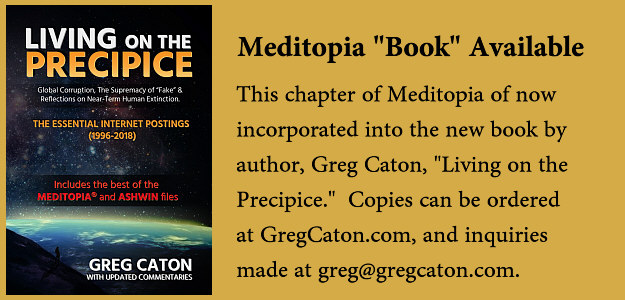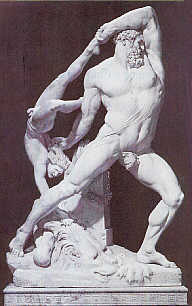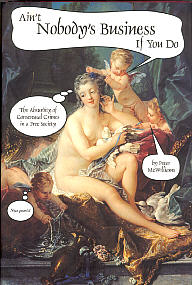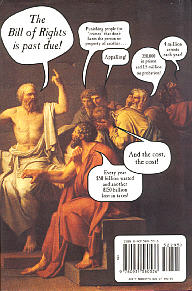
e covered very briefly in
the Entropy chapter, the relationship between localized and
centralized authority and control on the Exosomatic Axis.
A highly centralized government, or control mechanism, goes
hand-in-hand with a highly exosomatic system. This chapter
discusses the end result of having one of those highly
centralized centers of authority, as it pertains to the
making, labelling, buying and selling of foods, beverages,
medicinals, and just about every product a human would
internally consume. In the U.S. that entity is called
the Food & Drug Administration. From Miami, Florida
to the northern tip of Alaska (excepting your passage
through Western Canada), from San Diego, California,
to the northern tip of Maine; overseeing this very
basic area of human life for a population approaching
$300 billion,
but influencing through political manueverings the
very same function for the rest of the planet's
$6.5 billion
humans, is the U.S. FDA -- an agency that brags that
it oversees "
items accounting for 25 cents of every dollar
spent by consumers".

The FDA is a vast enterprise
with an annual budget of about
$1.7 billion.
The reason for its existence is sensible enough. On
its own
brief
history page, the FDA recounts its emergence with the
passage of the Federal Food & Drugs Act in 1906.
This act was spurred by the exposé,
The Jungle,
written by Upton Sinclair, wherein the meatpackaging
industry was exposed for unsanitary and adulterated
practices that would make any person of conscience
shutter. If you have a capitalistic system where food producers
are motivated to cut costs in order to save money -- often in
ways that are injurious to the customer (by its nature we
already know its injurious to the animals), you are
going to need regulatory oversight. This just makes
good sense. For the rest of this discussion, we can
sensibly exclude FDA practices of inspecting food and
drug producers to make sure their facilities meet good
manufacturing practices and kindred actions that
would aptly be described as a function of good governance.

What a highly
centralized organization like the FDA does -- and its structure,
I will argue, is endemically corrupt beyond any chance of
reform -- is define what is and what is not a drug;
what therapies are approved for commerce; who
gets to sell those drugs and from what approved
sources; what is and what is not "adulterated" or
"mislabelled." If you think the definitional lines
are clearcut, I have a rude awakening for you. Despite
the very girth and specificity of its CFR 21, they
are not -- and, in fact, depending on what a given
threat might pose to an FDA "client" in the pharmaceutical
industry, the definition can be extremely arbitrary --
conflicting with all law, custom, or reason.
In my own personal case, the FDA had me
plead guilty to selling "unapproved drugs" which were
clearly herbal products whose labels and corresponding
web pages clearly stated,
"To U.S. Users: This product
is not intended to diagnose, prevent, treat, or cure
any disease." It was not, in the end, enough for them
to not use coercive tactics to eliminate products that
clearly worked better than their pharmaceutical
equivalents, at a fraction of the cost, and with no
toxic side-effects (specifically, H3O and Cansema Tonic III --
see
Chapter 3).
This underscores the heart of the matter and helps us understand
why the FDA cannot serve the public interest -- expressed
in its simplest terms, the FDA cannot
serve two masters. It can either serve the interests of
the public, or it can serve the interests of the pharmaceutical
companies it was originally designed to oversee. Long ago,
the FDA, as an institution, made its decision.

If the system in the U.S.
were to lean close to the endosomatic end of the axis, it would
be the states (or even small political divisions) that regulated
food and drugs "through local health codes, honest-weight
restrictions, and other local regulatory laws."
3 Using interstate
commerce as the leverage to strip states of this responsibility
(which is rightful exosomatic thing to do), the FDA has
assumed the lion's share of those tasks -- to the
immeasureable detriment of the American people.

The vast sea of corruption
that the sequestering of this much power has wrought is the
subject of many books, many of which I posted
on the
Alpha Omega Labs web site. For some unexplainable
reason, most Americans are able to understand the basic concept
behind tyranny and too much centralization, but not the ways
in which it might threaten them. When Oliver Wendell Holmes
said, in an oft-cited quotation, that "power corrupts and
absolute power corrupts absolutely," he did not add a
caveat that this principle did not apply if standing in a
U.S. government jurisdiction. This appears to allude the
unwashed masses, or perhaps it is that they know how powerless
they are to change it.

That the master of
the FDA is the AMA, the medical research industry, and
the pharmaceutical companies -- the very corporate entities they are supposed
to oversee, and not the American people --
has been discussed
ad neaseum -- but to what
resulting reform? "The Food & Drug Administration is
intimately connected with the American Medical Association
and the handful of pharmaceutical companies that create
and manufacture the vast majority of prescription drugs," echoes
McWilliams. "Working at the FDA, being on the board of the
AMA, and working for one or another of the large pharmaceutical
companies, is like playing musical chairs. The high-paying
jobs -- the gold ring on the merry-go-round -- are at
pharmaceutical companies. The best way to get a raise
is to become a 'public servant' for a couple of years
and spend some time at the FDA or AMA."
4

Patronage costs money.
Lots and lots of money. And as we saw in
Chapter 5,
you cannot generate huge profits
without devoting
yourself to the exosomatic end of our axis -- in the exact
location where health care is ultimately most absent --
to the competitive exclusion of more effective endosomatic
solutions. To attempt to do so is to fight nature.
In its simplest terms, that is precisely what the FDA is:
an institution with an unwritten, declaration of war against
Mother Nature. No wonder there are so many
"forbidden cures" that, like
Cansema,
are so highly effective, inexpensive, and non-toxic that the
FDA has no choice but to place them on its
"list-of-effective-products-we must exterminate" list. The high cost of
patronage requires it.

The dangers inherent
in centralized government were not outside the purview
of the founding fathers. It was a nagging problem for
Thomas Jefferson -- such that his nemesis,
Alexander Hamilton, a grand apologist of
federal overreach, was moved to make such inane
justifications as, "Allowing the utmost latitude
to the love of power which any reasonable man
can require, I confess I am at a loss to discover
what temptation the persons intrusted with the administration
of the general government could ever feel to divest
the States of . . . authorities. The regulation
of the mere domestic police of a State appears
to me to hold out slender allurements to ambition.
Commerce, finance, negotiation, and war seem to
comprehend all the objects which have charms
for minds governed by that passion; and all the
powers necessary to those objects ought in the
first instance to be lodged in the national
depository."
5

The problem
with the FDA isn't the people who now work there,
or the laws they are entrusted to enforce (over
which they ride roughshod as they please anyway),
and certainly not the basic principles under which
it was constructed. The road to hell is paved
with good intentions -- and $1.7 billion a year
will give that road a pretty thick gold plating.

The problem is that the
very structure itself makes untold corruption
predictable, inevitable, multiplicitous, and
unbearably aggregious. That millions of
people over the last century have endured
painful deaths at the hands of FDA-approved
chemotherapy, radiation, and radical surgery,
when there existed more endosomatic dominant
treatments that would have worked effectively,
inexpensively, and without toxic repercussion,
means nothing if the mechanism behind this
FDA-approved holocaust cannot be identified.

I believe it can . . .

Or I would not have written this book.

If we go back to Justice Holmes
simple observation -- again, that "power corrupts and absolute
power corrupts absolutely," what does that mean in terms of
our axis? What it means is that lateral movement to the right
on the axis -- towards highly centralized, exosomatic,
profit-oriented, high entropy policy . . . or regulation . . .
or government in general, is an open invitation to
the "undercover dictatorship" Dr. Rush forewarned.

If you want
a true democracy -- power in the hands of the ordinary
citizen, you have to shift the "power center
of gravity" towards that citizen. Governmental power carries
with it a certain kind of gravitational force -- money and
power are the attractors of that force. If you concentrate
that power in one location, you magnify the force and you
make money and power the dominant "be all and end all".
If you shift that power towards the locality of the individual,
you diffuse the potential powers of misuse that are
inherent to highly centralized power.

Every political unit --
be it the governing entity behind a city, state, or nation --
comprises a dynamic vortex, much like a black hole. A number of
factors provide the elements that enlarge or reduce the
"gravitational field" of that vortex proportionally.
These include territory, resources (including financial
wherewithal), and people -- all interrelated. The larger
the vortex, the more inherently corrupt it becomes.
You can see this inherently in Icke's
Pyramid of Manipulation, because
from the view within the pyramid looking up, all "lines of power"
flow to a center, a point, the capstone, the one
all-controlling eye at the peak. (It is both
ironic and synchronicitous that this masonic image
should appear so prominently on our currency.)

This is
exosomaticity at its extreme. This is the pendulum
of life when it has moved to the far right and it
can move no farther -- when it cannot avoid the
need to restore equilibrium and move back to the
center. Man will always have some need for
the exosomatic. We would all be naked
breatharians without some need for tools.
Perhaps the purely endosomatic exists in
spirit form only. But, there
is
a state of equilibria. There is such a thing as balance.
It exists when you have
real democracy --
not the political "theater of the absurd" that
now operates in the U.S. and merely "pretends" to
be real democracy. It exists when you have done all
you can to marginalize the power vortices so
that government serves the common people, and
not the other way around.

The FDA is
a genetically defective polity simply because it cannot
forsake its exosomatic roots. It is corrupt because
it is not capable of being otherwise; it is in its
nature, as surely as a carnivarous cheetah cannot
forsake its need to hunt, kill and eat game.

The FDA is
a creature of the Matrix. It cannot be reformed.
To escape its vastly corrupt influence, you cannot
change it. You can only make a commitment to become
unplugged. And to become unplugged you must want
it more than anything else in the world. You must
fight for your liberty "not with lance and
shield, but with your very teeth and nails."







